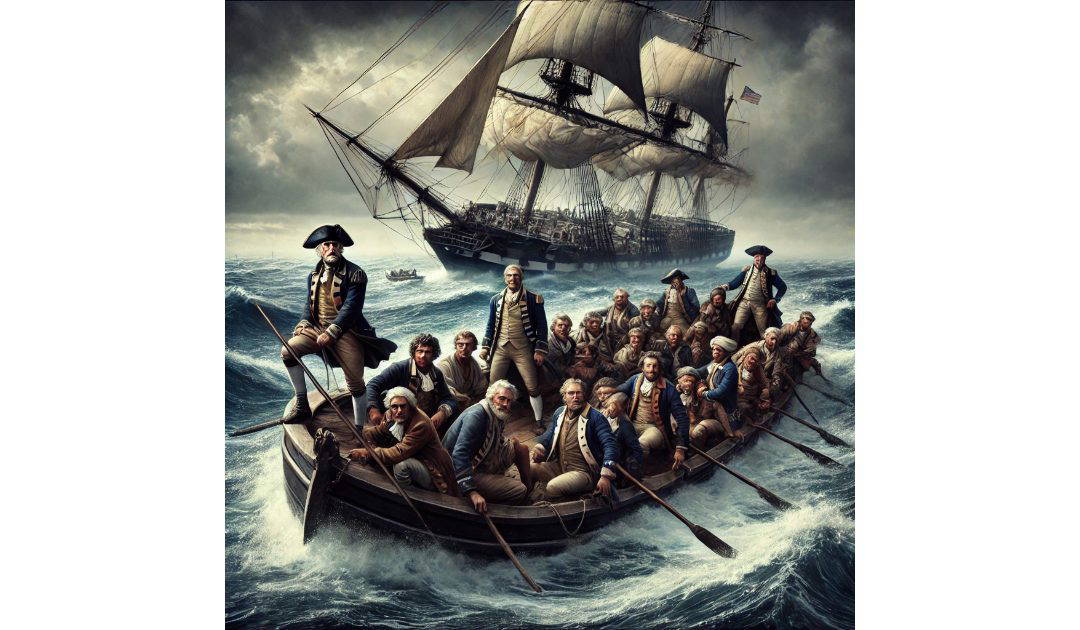On the 28th of April 1789, Lieutenant William Bligh and eighteen sailors were set adrift in a small boat following the mutiny on HMS Bounty. I’ve posted about my favourite films, but didn’t think of Mutiny on the Bounty.
The Mutiny on the Bounty is one of the most notorious naval uprisings in history, capturing the imagination of many through its tales of adventure, betrayal, and survival on the high seas. The story unfolds aboard the HMS Bounty and involves a conflict between its commanding officer, Lieutenant William Bligh, and his crew, leading to a rebellion that has been retold in various books, films, and documentaries.
The HMS Bounty set sail from England in December 1787, under the command of Lieutenant William Bligh. The mission was to transport breadfruit plants from Tahiti to the West Indies, as a means to provide a cheap and plentiful food source for enslaved people in the Caribbean. The Bounty was a small vessel, specially adapted for the task, with a crew of 46 men.
Bligh, a seasoned sailor and former shipmate of the legendary Captain Cook, was known for his navigational prowess. However, his leadership style was often described as harsh and demanding, leading to increasing tensions aboard the ship as the journey progressed.
After a lengthy journey across treacherous seas, the Bounty arrived in Tahiti in October 1788. It was a paradise for the sailors, who were welcomed by the islanders and quickly grew accustomed to the relaxed lifestyle, the abundant food, and the warm hospitality of the local people. The crew formed close bonds with the Tahitians, and many had romantic relationships with the island women.
During their five-month stay, the breadfruit plants were successfully collected and prepared for the next leg of the journey. However, the extended period on the island had a profound impact on the crew, making the return to the rigid discipline of ship life increasingly unattractive.
On the 28th of April, 1789, tensions reached a breaking point. Led by Fletcher Christian, the master’s mate, a group of discontented sailors seized control of the Bounty. They took advantage of Bligh’s unpopularity and captured him and 18 loyalists, setting them adrift in a small 23-foot open boat, known as a launch, in the middle of the South Pacific.
Bligh’s experience and skill as a navigator proved crucial; he and his loyalists managed to survive a perilous 3,600-mile journey to Timor, an incredible feat of seamanship and endurance.
Meanwhile, the mutineers sailed the Bounty back to Tahiti, where some chose to remain. The rest, led by Christian, eventually settled on Pitcairn Island, a remote and uninhabited speck in the Pacific Ocean. There, they burned the ship to avoid detection and started new lives.
Back in England, Bligh’s incredible survival story and the subsequent court-martial of captured mutineers stirred public interest and debate. While Bligh was eventually cleared of any wrongdoing, his reputation as a leader was forever tarnished. The British Admiralty dispatched ships to apprehend the mutineers, leading to the capture and trial of some, while others evaded capture permanently.
The Mutiny on the Bounty has inspired countless interpretations and analysis over the years. It raises questions about leadership, loyalty, and the human spirit’s resilience in the face of adversity. The story has been immortalised in several books, such as “Mutiny on the Bounty” by Charles Nordhoff and James Norman Hall, and in films like the 1935 Clark Gable version, the 1962 blockbuster featuring Marlon Brando, and the 1984 rendition starring Mel Gibson and Anthony Hopkins.
While the mutiny initially painted Bligh as a tyrant and Christian as a romantic hero, modern historians have delved deeper into the complexities of their characters and the circumstances they faced.
Ultimately, the Mutiny on the Bounty remains a multifaceted tale of human nature, leadership challenges, and the quest for freedom. Whether seen as a tragic event or an unavoidable uprising, it continues to captivate audiences, offering timeless lessons on the potential for conflict and the capacity for courage in pursuit of one’s beliefs.

